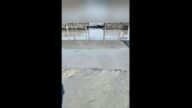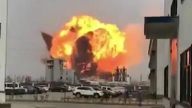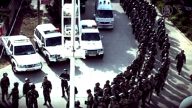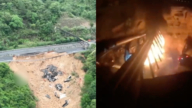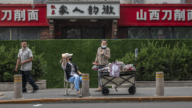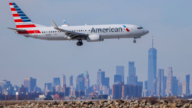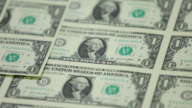【新唐人2014年06月06日訊】中共環保部6月4號發佈《2013中國環境狀況報告》,報告說,依據新的「環境空氣質量標準」,去年中國74個城市中,僅3個城市的空氣質量達標,而10個空氣最差的城市,有7個在河北。
6月5號是「世界環境日」。中共環境保護部官員4號表示,大陸去年的空氣質量,京津冀、長三角、珠三角三大重點區域的74個城市中,僅海口、舟山和拉薩3個城市達標。而去年全中國霧霾日數平均有35.9天,比上年增加18.3天,為1961年以來最多。
早在今年的1月10號,國際非政府組織「綠色和平」,已發佈了中國74 個城市2013年的PM2.5年均濃度排名。
「綠色和平」的這項排名顯示,中國的空氣污染問題在長三角地區日趨嚴重,中西部省份也凸顯出空氣污染的問題。
而在實施《環境空氣質量標準》監測的這74座城市中,空氣PM2.5懸浮粒子的年均濃度,有近92%的城市達不到國家標準,其中32座城市的PM2.5年均濃度是國家標準的2倍以上。而排行前十名的城市,PM2.5年均濃度幾乎是國家標準的3倍以上,其中有7個城市位於河北省。
特別是排在前兩位的河北邢臺、和石家莊的年均PM2.5濃度,是國家標準的4倍以上。
而美國的調查指標顯示,去年北京僅有13天空氣質量良好。
「綠色和平」組織東亞氣候和能源活動家方立峰曾經表示:中國已有數百萬的人口,面臨著一年有三分之一天的重度污染空氣。另有一些地區,一年12個月,幾乎沒有好空氣。
美國《外交政策》雜誌6月4號報導說,四月份一份官方研究發現,近十分之一的中國農田被污染,還有五分之三的中國地下水被污染。
中共環境保護部官員在4號的《中國環境狀況報告》發佈會上表示,將努力打好「向污染宣戰」的所謂「三大戰役」,也就是﹕大氣污染防治、水污染防治,和土壤污染防治。
北京水污染環保自願者張峻峰﹕「我們並沒有認清楚產生這些空氣、水和固體污染的一些狀況的基本原因是甚麼。在沒有認清楚的狀況之下,就提出這樣的目標,實在是有些盲人摸象的一種狀況。」
中國財經、社會問題評論家鞏勝利﹕「你剛才講到這個環境問題、水、土、空氣,這是中國自己的事情當然要中國自己來做,但是,沒有老百姓的參與,沒有全體公民的參與,光是你官方自己上,我覺得可能也是非常難的難點。沒有它的制衡,沒有相反的意見,或者沒有科學技術、理論的爭論,或者是權衡,可能會出現誤差,或者是適得其反。」
中國財經、社會問題評論家鞏勝利提出,中共最高層的決策,包括三峽水利工程,和文化大革命、大躍進、三反、五反,實施結果卻是天怒人怨,成為人類的災難。這次中共「向污染宣戰」,特別需要科學來論證。
《外交政策》的報導說,由北京及中國東北美僑商會進行的調查發現,48%的受訪者表示,由於污染問題,難以在中國招聘或留住高級主管。
去年10月,中國東北的大部分地區都被濃密的霧霾覆蓋,包括黑龍江、吉林、遼寧等省分。黑龍江哈爾濱市機場被迫關閉,兩千多所學校停課。霧霾也導致黑龍江省境內多條高速公路被迫關閉。
英國《金融時報》在今年早些時候的一篇報導中,用「空氣末日」(Airpocalypse)來形容北京的霧霾天氣。報導說,日益惡化的污染問題,促使一些在華工作的外籍人士,提前離開中國,增加了外國企業在華投資成本。
據「綠色和平」組織發佈的一項調查顯示,基於中國政府給出的PM2.5數據顯示,空氣污染增加了肺癌和心臟衰竭的病發率。
張峻峰﹕「像我們現在所遇見的所有的社會問題,甚至於包括新疆的問題,或者對社會進行報復的這樣一些事件,都和我們的經濟發展模式息息相關,而不是毫無關聯的。如果認識到這一點,或者從這個角度,來認識我們當今社會問題的話,可能污染問題才有可能得到緩解,或者往緩解的方向在邁進。」
「世界衛生組織」駐中國代表今年2月表示,中國城市的空氣污染問題,應該被視為「危機」來處理。
採訪/朱智善 編輯/周平 後製/鍾元
Seven of Top Ten Most Polluted Chinese Cities Are In Hebei Province
The Pollution Report 2013 was released by China
Ministry of Environmental Protection on June 4.
According to the report, only 3 out of 74 Chinese
cities measured met new air quality standards.
Among the 10 worst cities for air quality,
seven of them are located in Hebei Province.
June 5 is World Environment Day.
The Chinese authorities released their
report, indicating that last year, only Haikou,
Zhoushan and Lhasa met air quality standards.
The report surveyed a total of 74 cities,
including Beijing, Tianjin, cities in Hebei,
the Yangtze and Pearl River Deltas.
Smog days were averaged 35.9 days last year,
which is an 18.3 day increase from last year.
This is the most severe occurence since 1961.
On January 10, international NGO Greenpeace released
it’s rankings for the air quality of 74 Chinese cities in 2013.
This was based on average annual
particle pollution concentrations, or PM2.5.
The Greenpeace rankings showed the Yangtze
River Delta region was the hardest hit area.
Western provinces showed
emerging issues in air pollution.
In the monitoring program Ambient Air Quality Standards,
92% of cities failed to meet the state standard of PM2.5.
Thirty two cities had twice the limit of the PM2.5.
The top 10 worst air cities had three
times the minimum level of PM 2.5.
Seven of these cities are located in Hebei.
In particular, Xingtai and Shijiazhuang had an annual
PM2.5 concentration of four times that of the minimum.
The U.S. survey showed that there were only
13 days last year that had good air quality in Beijing.
Greenpeace East Asia climate and energy campaigner
Fang Lifeng has commented that Millions of Chinese
are facing severe air pollution for one third of a year.
Some areas rarely have any good air for the entire year.
Foreign Policy magazine’s recent report
indicates that, nearly one-fifth of farmland is
polluted, an official government study found in
April, and so is three-fifths of China’s groundwater.
In a recent press release for the Pollution Report
2013, Chinese officials indicated that they will strive
in the battle to control pollution of air, water, and soil.
Zhang Junfeng, environmentalist, Beijing: “We have not
had a clear understanding of the cause of the pollution.
The official claims for anti-pollution actions are pointless.”
Gong Shengli, commentator: “Speaking on the
issue of pollution in water, soil and air, of course
the Chinese populace need to take care of it.
Without the participation of the people,
the claims of the official makes it hard.
It takes a check and balance of the policies,
ideas and debates in science and technology.
Otherwise, the effect will be counterproductive.”
Commentator Gong Shengli highlights past examples
of the Chinese regime’s actions and decisions;
the Three Gorges Dam, the Cultural
Revolution, and the Great Leap Forward.
All have only resulted in outrageous
results and caused human catastrophes.
He stresses the official battle against
pollution is in need of scientific proof.
A recent survey by the Beijing and Northeast China
chapters of the American Chamber of Commerce found
that 48 percent of respondents “cited difficulty recruiting
or retaining senior executives in China due to pollution.”
This is what was reported in Foreign Policy.
Last October, thick haze covered
most parts of northeast China.
This includes Heilongjiang, Jilin,
Liaoning and other provinces.
The Airport and more than 2,000
schools were forced to close in Harbin.
Haze has also forced Heilongjiang
Province to close a number of highways.
The Financial Times has reported earlier this year that the
Airpocalypse in Beijing has forced foreign executives to leave
China earlier and increased the cost in the investment in China.
The Greenpeace survey also indicated higher lung
cancer and heart failure rates as a result of air pollution.
This was based on the PM2.5
data from the regime officials.
Zhang Junfeng: “It is like all of the social
problems we have encountered.
Everything is closely related to our
model of economic development.
Only by recognising this will we step towards relieving
the issues in social problems, as well as in pollution.”
The World Health Organization representative
in China said in February this year that urban
pollution in China should be dealt with as a “crisis".
Interview/Zhuzisan Edit/Zhoupin Post-Production/Zhongyuan




